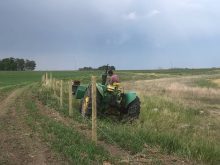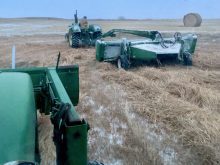When building barbed-wire fence, you need an easy way to unroll the wire spools. Many methods have been used, such as putting the spool on a stationary bar and then pulling the wire along the fence line.
People often put a bar or pole across the end of a pickup, putting the roll on it, attaching the end of the wire to the fence post, and driving along to unroll the wire. Another method is to secure the bar next to the fence and then take the end of the wire and attach it to a four-wheeler to pull and unroll the wire along the fence.
Read Also

Harvest wraps up and fall work begins
At the Eppich famly ranch in western Saskatchewan, the fall harvest was successful with few breakdowns, cows and calves have been sorted and a new tractor has arrived
A simpler and easier method was devised 10 years ago by my husband Lynn Thomas when he needed to build several miles of fence with limited crew and waning strength (he is now 78.) He says necessity was the mother of his invention.
He looked at a homemade unroller that one of our neighbours gave him. This was a device attached to the rear bumper of a pickup. It was a U-shaped piece of metal a little bigger than a roll of barbed wire, with a metal rod in the middle to hold the roll. The idea behind this creation was to park the pickup and pull the wire from it, or drive the pickup along the fence line to unroll the wire, with the end of the wire affixed to a post.
The problem with this method was that our ranch terrain (steep sagebrush-covered mountainsides) made this impossible; the wire had to be pulled by hand. The terrain was too rough and steep to pull the wire with a four-wheeler, let alone a pickup. And wire unrolled in this manner catches on sagebrush, then jerks free, causing the spool to unroll too fast and tangle.
Using materials at hand
Lynn created his own version by using one of the round, flat metal plates from the neighbour’s device. “A person could make a similar plate out of a piece of 3/8 inch metal, cutting it in a round circle about the diameter of a roll of barbed wire, putting a hole in the centre that a bar will fit through,” he says.
Lynn put a tire rim around the outside of the metal plate. The roll of wire sits on the flat metal plate with the tire rim around it. “Make sure the rim does not stick up beyond the plate,” he says. “It must be flush so the wire won’t catch on the rim.”

He used a 13-inch tire and rim from a small car. “It works best to leave the tire on the rim, to give it more stability,” Lynn says.
“One reason this works so well is that friction between the metal plate and the unrolling wire (the roll sitting on the plate with a bar through the centre), creates a little drag that acts like a brake. The wire won’t go spinning off it, out of control.”
Lynn used this method to unroll wire while building four miles of five-strand barbed wire fence that required more than 20 rolls of wire. He suggests placing the unroller at the spot you want to start the fence, making sure it sits flat. If necessary, use rocks under the plate to level it. Every stretch of fence should be unrolled on flat ground or heading downhill; it doesn’t work to pull the wire uphill. In steep country, set the unroller at the top of the hill and pull the wire down the hill.
To anchor the roll of wire as it sits on the flat plate, use a metal bar or rod put down through the middle of the spool and into the ground. Pound the rod into the ground a few inches to hold it in place.
This keeps the whole device in place even when pulling some long runs such as the whole roll of wire, which is about 1/4 mile. If you’re likely to use the whole spool, make sure the final end of the wire doesn’t come off it.
If the wire is pulled downhill, even in uneven, brushy terrain, two people can readily manage to get the wire strung out. One person starts down the hill holding and pulling one end of the wire, while the second person grabs hold about 75 or 100 feet back of the front person to give some added pull.
“With this device, unrolling this much wire, I never had any problems,” says Lynn. “We’ve never had anything that worked as well as this — and we’ve built more than 25 miles of fence over the past 55 years on this ranch.”















